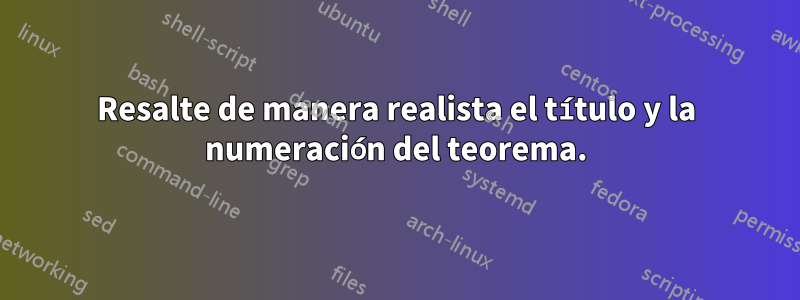
Recientemente me encontré con estopublicación increíble sobre resaltado de texto interesante en LaTeXy la respuesta correspondiente de @Antal Spector-Zabusky. Quiero implementar este resaltado en mis apuntes de clase. En particular, tengo múltiples entornos definidos (como definición, comentario y proposición) (usando mdframedy amsthm).
Aquí hay un ejemplo mínimo.
\documentclass{report}
\usepackage{amsthm}
\usepackage{xcolor}
\usepackage{mdframed}
\definecolor{superlight}{HTML}{F5F5F5}
\mdfdefinestyle{basic-gray-box}{backgroundcolor=superlight}
\setlength{\parindent}{0pt}
\newtheoremstyle{mystyle}
{}
{}
{\itshape}
{}
{\bfseries}
{.}
{ }
{\thmname{\highlight{#1}}\thmnumber{ #2}\thmnote{ (#3)}}%
\theoremstyle{mystyle}
\newmdtheoremenv[style=basic-gray-box]{proposition}{Satz}[chapter]
% Highlight
\usepackage{soul}
\usepackage{tikz}
\usetikzlibrary{calc}
\usetikzlibrary{decorations.pathmorphing}
\makeatletter
\newcommand{\defhighlighter}[3][]{%
\tikzset{every highlighter/.style={color=#2, fill opacity=#3, #1}}%
}
\defhighlighter{yellow}{.5}
\newcommand{\highlight@DoHighlight}{
\fill [ decoration = {random steps, amplitude=2pt, segment length=15pt}
, outer sep = -30pt, inner sep = 0pt, decorate
, every highlighter, this highlighter ]
($(begin highlight)+(0,8pt)$) rectangle ($(end highlight)+(0,-3pt)$) ;
}
\newcommand{\highlight@BeginHighlight}{
\coordinate (begin highlight) at (0,0) ;
}
\newcommand{\highlight@EndHighlight}{
\coordinate (end highlight) at (0,0) ;
}
\newdimen\highlight@previous
\newdimen\highlight@current
\DeclareRobustCommand*\highlight[1][]{%
\tikzset{this highlighter/.style={#1}}%
\SOUL@setup
%
\def\SOUL@preamble{%
\begin{tikzpicture}[overlay, remember picture]
\highlight@BeginHighlight
\highlight@EndHighlight
\end{tikzpicture}%
}%
%
\def\SOUL@postamble{%
\begin{tikzpicture}[overlay, remember picture]
\highlight@EndHighlight
\highlight@DoHighlight
\end{tikzpicture}%
}%
%
\def\SOUL@everyhyphen{%
\discretionary{%
\SOUL@setkern\SOUL@hyphkern
\SOUL@sethyphenchar
\tikz[overlay, remember picture] \highlight@EndHighlight ;%
}{%
}{%
\SOUL@setkern\SOUL@charkern
}%
}%
%
\def\SOUL@everyexhyphen##1{%
\SOUL@setkern\SOUL@hyphkern
\hbox{##1}%
\discretionary{%
\tikz[overlay, remember picture] \highlight@EndHighlight ;%
}{%
}{%
\SOUL@setkern\SOUL@charkern
}%
}%
%
\def\SOUL@everysyllable{%
\begin{tikzpicture}[overlay, remember picture]
\path let \p0 = (begin highlight), \p1 = (0,0) in \pgfextra
\global\highlight@previous=\y0
\global\highlight@current =\y1
\endpgfextra (0,0) ;
\ifdim\highlight@current < \highlight@previous
\highlight@DoHighlight
\highlight@BeginHighlight
\fi
\end{tikzpicture}%
\the\SOUL@syllable
\tikz[overlay, remember picture] \highlight@EndHighlight ;%
}%
\SOUL@
}
\makeatother
\begin{document}
\chapter{}
What the highlighting looks like:
\begin{proposition}\end{proposition}
What I want it to look like: \\
\textbf{\highlight{Satz 1.1. (my title)}}
\end{document}
Esto produce un documento como este:
En particular, tenga en cuenta que se elimina la "aleatoriedad" en el resaltado (es solo un cuadro transparente alrededor de "Satz"). También quiero que el resaltado abarque todo el título (Satz, numeración, nombre).
¿Cómo puedo abordar esto?
Respuesta1
Este es un problema de expansión. Es necesario ampliar el argumento del \highlightprimero. Aquí tienes una forma de hacerlo. Define una variante, \Highlightque expande el argumento primero. (Por supuesto, hay otras formas, por ejemplo, usando \expandafter).
\documentclass{report}
\usepackage{amsthm}
\usepackage{xcolor}
\usepackage{mdframed}
\definecolor{superlight}{HTML}{F5F5F5}
\mdfdefinestyle{basic-gray-box}{backgroundcolor=superlight}
\newcommand\Highlight[1]{\edef\temp{\noexpand\highlight{#1}}%
\temp}
\setlength{\parindent}{0pt}
\newtheoremstyle{mystyle}
{}
{}
{\itshape}
{}
{\bfseries}
{.}
{ }
{\Highlight{\thmname{#1}\thmnumber{ #2}\thmnote{ (#3)}}}%
\theoremstyle{mystyle}
\newmdtheoremenv[style=basic-gray-box]{proposition}{Satz}[chapter]
% Highlight
\usepackage{soul}
\usepackage{tikz}
\usetikzlibrary{calc}
\usetikzlibrary{decorations.pathmorphing}
\makeatletter
\newcommand{\defhighlighter}[3][]{%
\tikzset{every highlighter/.style={color=#2, fill opacity=#3, #1}}%
}
\defhighlighter{yellow}{.5}
\newcommand{\highlight@DoHighlight}{
\fill [ decoration = {random steps, amplitude=2pt, segment length=15pt}
, outer sep = -30pt, inner sep = 0pt, decorate
, every highlighter, this highlighter ]
($(begin highlight)+(0,8pt)$) rectangle ($(end highlight)+(0,-3pt)$) ;
}
\newcommand{\highlight@BeginHighlight}{
\coordinate (begin highlight) at (0,0) ;
}
\newcommand{\highlight@EndHighlight}{
\coordinate (end highlight) at (0,0) ;
}
\newdimen\highlight@previous
\newdimen\highlight@current
\DeclareRobustCommand*\highlight[1][]{%
\tikzset{this highlighter/.style={#1}}%
\SOUL@setup
%
\def\SOUL@preamble{%
\begin{tikzpicture}[overlay, remember picture]
\highlight@BeginHighlight
\highlight@EndHighlight
\end{tikzpicture}%
}%
%
\def\SOUL@postamble{%
\begin{tikzpicture}[overlay, remember picture]
\highlight@EndHighlight
\highlight@DoHighlight
\end{tikzpicture}%
}%
%
\def\SOUL@everyhyphen{%
\discretionary{%
\SOUL@setkern\SOUL@hyphkern
\SOUL@sethyphenchar
\tikz[overlay, remember picture] \highlight@EndHighlight ;%
}{%
}{%
\SOUL@setkern\SOUL@charkern
}%
}%
%
\def\SOUL@everyexhyphen##1{%
\SOUL@setkern\SOUL@hyphkern
\hbox{##1}%
\discretionary{%
\tikz[overlay, remember picture] \highlight@EndHighlight ;%
}{%
}{%
\SOUL@setkern\SOUL@charkern
}%
}%
%
\def\SOUL@everysyllable{%
\begin{tikzpicture}[overlay, remember picture]
\path let \p0 = (begin highlight), \p1 = (0,0) in \pgfextra
\global\highlight@previous=\y0
\global\highlight@current =\y1
\endpgfextra (0,0) ;
\ifdim\highlight@current < \highlight@previous
\highlight@DoHighlight
\highlight@BeginHighlight
\fi
\end{tikzpicture}%
\the\SOUL@syllable
\tikz[overlay, remember picture] \highlight@EndHighlight ;%
}%
\SOUL@
}
\makeatother
\begin{document}
\chapter{}
What the highlighting looks like:
\begin{proposition}[my title]
\end{proposition}
What I want it to look like: \\
\textbf{\highlight{Satz 1.1. (my title)}}
\end{document}
Para colocar el punto encima de la región resaltada, puedes usar
\documentclass{report}
\usepackage{amsthm}
\usepackage{xcolor}
\usepackage{mdframed}
\definecolor{superlight}{HTML}{F5F5F5}
\mdfdefinestyle{basic-gray-box}{backgroundcolor=superlight}
\newcommand\Highlight[1]{\edef\temp{\noexpand\highlight{#1}}%
\temp}
\setlength{\parindent}{0pt}
\newtheoremstyle{mystyle}
{}
{}
{\itshape}
{}
{\bfseries}
{\hspace*{-1ex}.}
{ }
{\Highlight{\thmname{#1}\thmnumber{ #2}\thmnote{ (#3)}~}}%
\theoremstyle{mystyle}
\newmdtheoremenv[style=basic-gray-box]{proposition}{Satz}[chapter]
% Highlight
\usepackage{soul}
\usepackage{tikz}
\usetikzlibrary{calc}
\usetikzlibrary{decorations.pathmorphing}
\makeatletter
\newcommand{\defhighlighter}[3][]{%
\tikzset{every highlighter/.style={color=#2, fill opacity=#3, #1}}%
}
\defhighlighter{yellow}{.5}
\newcommand{\highlight@DoHighlight}{
\fill [ decoration = {random steps, amplitude=2pt, segment length=15pt}
, outer sep = -30pt, inner sep = 0pt, decorate
, every highlighter, this highlighter ]
($(begin highlight)+(0,8pt)$) rectangle ($(end highlight)+(0,-3pt)$) ;
}
\newcommand{\highlight@BeginHighlight}{
\coordinate (begin highlight) at (0,0) ;
}
\newcommand{\highlight@EndHighlight}{
\coordinate (end highlight) at (0,0) ;
}
\newdimen\highlight@previous
\newdimen\highlight@current
\DeclareRobustCommand*\highlight[1][]{%
\tikzset{this highlighter/.style={#1}}%
\SOUL@setup
%
\def\SOUL@preamble{%
\begin{tikzpicture}[overlay, remember picture]
\highlight@BeginHighlight
\highlight@EndHighlight
\end{tikzpicture}%
}%
%
\def\SOUL@postamble{%
\begin{tikzpicture}[overlay, remember picture]
\highlight@EndHighlight
\highlight@DoHighlight
\end{tikzpicture}%
}%
%
\def\SOUL@everyhyphen{%
\discretionary{%
\SOUL@setkern\SOUL@hyphkern
\SOUL@sethyphenchar
\tikz[overlay, remember picture] \highlight@EndHighlight ;%
}{%
}{%
\SOUL@setkern\SOUL@charkern
}%
}%
%
\def\SOUL@everyexhyphen##1{%
\SOUL@setkern\SOUL@hyphkern
\hbox{##1}%
\discretionary{%
\tikz[overlay, remember picture] \highlight@EndHighlight ;%
}{%
}{%
\SOUL@setkern\SOUL@charkern
}%
}%
%
\def\SOUL@everysyllable{%
\begin{tikzpicture}[overlay, remember picture]
\path let \p0 = (begin highlight), \p1 = (0,0) in \pgfextra
\global\highlight@previous=\y0
\global\highlight@current =\y1
\endpgfextra (0,0) ;
\ifdim\highlight@current < \highlight@previous
\highlight@DoHighlight
\highlight@BeginHighlight
\fi
\end{tikzpicture}%
\the\SOUL@syllable
\tikz[overlay, remember picture] \highlight@EndHighlight ;%
}%
\SOUL@
}
\makeatother
\begin{document}
\chapter{}
What the highlighting looks like:
\begin{proposition}[my title]
blub bla blub
\end{proposition}
What I want it to look like: \\
\textbf{\highlight{Satz 1.1. (my title)}}
\end{document}





